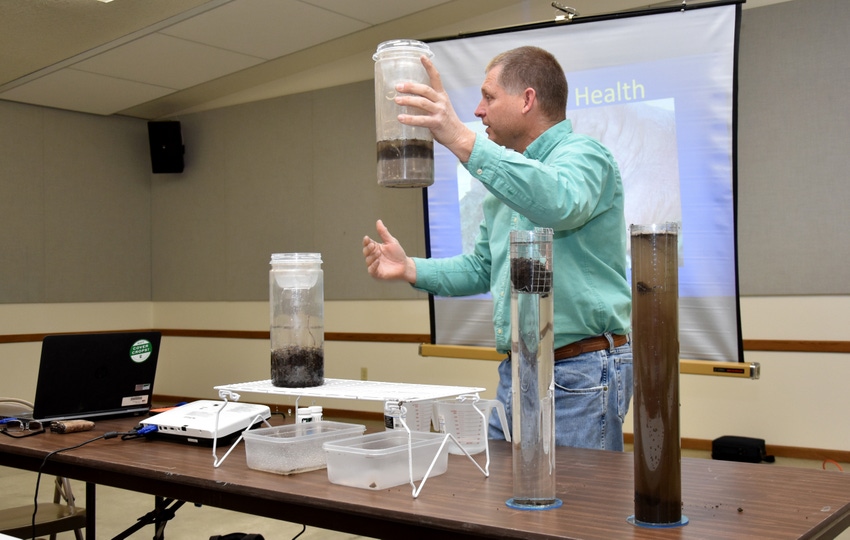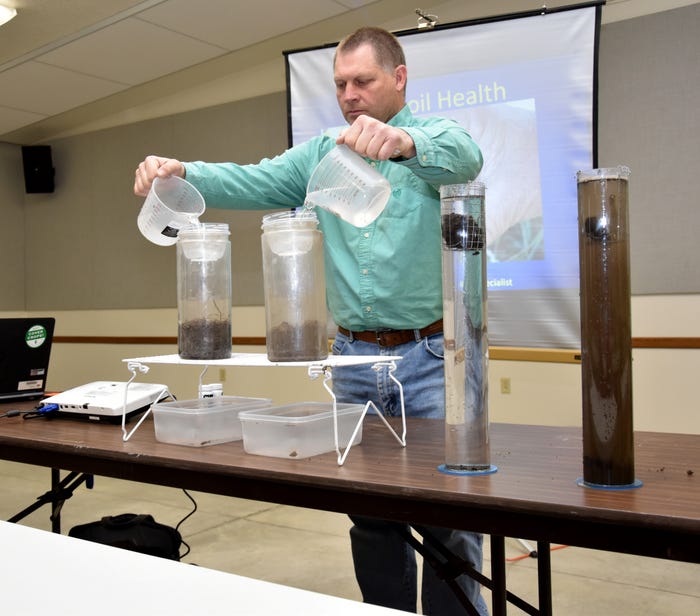April 24, 2018

--------
Think Different.
“Tillage fluffs the soil, and that helps water soak into the ground faster.” That’s what Doug Peterson was told over and over as he grew up and began farming years ago. Older and wiser, after conducting dozens of infiltration and slake tests comparing tilled and no-tilled soils from crop fields across Iowa and Missouri for the past five years, Peterson has seen time after time that that’s not the case.
The conservationist, farmer and soil health specialist for NRCS travels the two states showing groups of farmers how tilled soils collapse during the first rain after tillage, plugging pore spaces with settled soil particles—and setting the stage for poor water infiltration the rest of the season.
Peterson explains to audiences that tillage drastically reduces the populations of underground animal life that produce the glues that form soil aggregates. Those soil aggregates form the strong soil structure with clear airways that encourage water infiltration.
---------
As Doug Peterson travels across Iowa and Missouri to speak at local farmer meetings, he asks for soil samples from local fields to help illustrate his most important message. He uses the samples to compare the stability of soils in crop fields that are being tilled against those in no-till and cover cropped fields.

What he’s found, over and over again through a wide range of soil types, is that tilled soils are consistently unstable. And, contrary to most popular opinion, tilled soils constrict water infiltration.
“I’ve conducted the slake test and infiltration tests in demonstrations across the Midwest with many different soil types, and the demonstrations show without a doubt, tillage decreases infiltration,” Peterson says. “It’s counterintuitive—you would think water would soak more quickly through soil that had been stirred and loosened. And you would think a hard, compressed clod from a tilled soil would disintegrate more slowly in water than crumbly soil from a no-till and cover crop sample. But that’s not the case. It’s all about the aggregates.”
Peterson says his eyes were opened when he saw similar demonstrations at a soil health meeting about 10 years ago, and there’s been nothing in all the demonstrations he’s done since that would make him think any differently.
Tillage leads to compaction
“Farmers would tell you their heavy equipment causes soil compaction, and it does,” Peterson says. “But equipment isn’t the only thing that causes compaction. It’s the loss of aggregate stability. Tillage fluffs up the soil, but the next time it rains, the soil collapses and you have a muddy mess in your tilled field. The pore spaces in the soil fill with settled soil—that’s the definition of compaction.”

While respiration spikes right after tillage, ensuing rains seal the soil and respiration is low for the rest of the year, Peterson says.The loss of pore space, release of carbon that comes from tillage, and slow infiltration rates create problems in the soil—compaction, loss of organic matter, and loss of water holding capacity, among others. “Tilled soils are leaky in their ability to hold nutrients, too,” Peterson says. “They don’t have the biology like healthy soils have that grabs nutrients.” Tillage and the lack of rainfall infiltration into the soil is also the primary cause of runoff, sedimentation, and other problems off the farm. “Do we maximize infiltration on most of our cropland?” Peterson asks. “We don’t. Even in a drought, a heavy rain will cause flooding. That’s because the majority of our cropped fields have been sealed off with tillage.”
Aggregate formation
Soil aggregates are groups of soil particles that bind to each other more strongly than to adjacent particles. The crumbly structure of well-aggregated soil creates space between the aggregates—pore space that allows for retention and exchange of air and water in the soil.
“Soil organisms create aggregation with their glue-like secretions,” Peterson says. “Earthworms secrete the glue along their burrows, and the long, filamentous fungi organisms in the soil do even more than earthworms. The problem with tilled soils is tillage destroys the environment for soil microorganisms. Tilled soils have a very low fungal component, and you won’t find many earthworms in tilled soils.”
Plant roots also leak out exudates in nature’s system to attract soil organisms, and that helps glue the soil together as well. That’s one reason cover crops help build the soil.
Tillage ingrained into society
“Tillage is ingrained into our society—it may be more ingrained than language or religion,” Peterson says. “All the way back to when tillage started in the Middle East, it’s been passed down from generation to generation. It’s a fallacy that you have to till, when you have the tools we have. But, our ancestors weren’t stupid.”
“Think about what they did. Hundreds of years ago, they tilled the land, but moved to a different piece of land to farm after 3 to 5 years,” Peterson says. “When farmers first plowed up Iowa fields, they rotated crops. After tillage for one or two years, the land was back in grass for a few years. “I learned to till from my dad, who learned from his dad, who learned from his. But the part that’s missing from that now is the grass in the rotation.”
Peterson says it takes three to four years to destroy soil aggregation with tillage and the same time to build it back with no tillage and a diversity of grasses and legumes. “So, when our ancestors tilled the soil and it degraded, they built aggregates back and restored the soil with rotations. If you fluff up a well-aggregated, healthy soil, you actually can increase infiltration short term. When our fathers and grandfathers fluffed the soil that had been regenerated with grasses, they didn’t see quite the same problem with a lack of infiltration we see today in a corn-soybean rotation.”
Check out the slide show to view the results of Doug Peterson's test here.
About the Author(s)
You May Also Like




